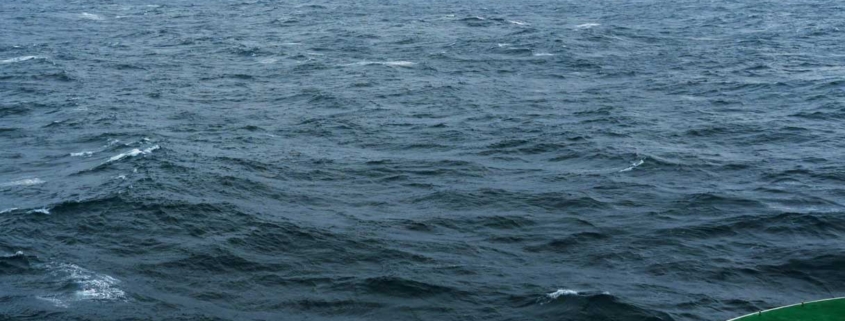Dwindling sea ice may speed melting of Antarctic glaciers
Expanded Ross Gyre would unleash warm water and disrupt ocean “conveyor belt”
 In February, on an icebreaker off the coast of West Antarctica, Robert Larter, a marine geophysicist with the British Antarctic Survey (BAS), came on deck to a startling sight: open gray water as far as the eye could see. There was no ice at all for the ship to break. The next day, satellite surveys would find sea ice around the continent hitting a record low.
In February, on an icebreaker off the coast of West Antarctica, Robert Larter, a marine geophysicist with the British Antarctic Survey (BAS), came on deck to a startling sight: open gray water as far as the eye could see. There was no ice at all for the ship to break. The next day, satellite surveys would find sea ice around the continent hitting a record low.
Unlike fast-shrinking Arctic sea ice, the sea ice ringing Antarctica seemed more resistant to climate change—until recently. But now a long-term decline may have set in, and it could have unexpected and ominous domino effects, according to several recent studies. Dwindling sea ice could strengthen a whirling current called the Ross Gyre, bringing warm waters closer to land and hastening the collapse of the West Antarctic ice sheet, which locks up enough water to raise global sea levels by 3.3 meters. The warmer water and glacial melt expected from a stronger gyre already show hints of slowing part of the global ocean’s overturning circulation, a critical “conveyor belt” of currents that distributes heat and removes carbon dioxide from the atmosphere. “These are pretty grim predictions,” Larter says. “There are a lot of bad consequences if we really are on a downward sea ice trend.”
Although climate models predict an eventual decline in Antarctic sea ice, the ice cover was actually expanding slightly until a decade ago. Then from 2014 to 2017, the ice began to vanish rapidly, losing more in 3 years than the Arctic had lost in 3 decades, says Claire Parkinson, a climatologist at NASA’s Goddard Space Flight Center. “It was just astonishing.” The ice rebounded for a few years, then resumed its downward march, reaching record lows last year and again this year.
This erratic behavior makes it difficult to know whether the ice’s long-term decline has begun in earnest, says Clare Eayrs, a sea ice researcher at the Korea Polar Research Institute. “There has been substantial variability in total Antarctic sea ice over the last decade,” she says. “We don’t know yet why this is.” Short-term climate swings like El Niño and fluctuations in the Southern Ocean’s roaring winds are probably playing a role, she says. But in some regions—including the seas off West Antarctica—a decline is already unmistakable.
In these waters, hidden beneath sea ice, spins the 1000-kilometer-wide Ross Gyre, fed by warm currents from farther north. Felipe Gomez Valdivia, a physical oceanographer at BAS, and his colleagues wanted to find out how declining sea ice might affect the gyre. Using the UK Earth System Model, a next-generation climate model, they found that as sea ice thinned, the force of surface winds on newly exposed water strengthened the gyre and expanded it, according to a study published last month in Geophysical Research Letters. The larger gyre brought warm water closer to the glaciers of West Antarctica, which spill out into the ocean as ice shelves and are vulnerable to melting from below. Within 30 years of its expansion, the gyre could warm the waters beneath the glaciers by 1°C, Valdivia says—an unprecedented heat wave that would accelerate erosion of the ice.
Most alarming, the gyre expanded even in scenarios where greenhouse emissions dropped and climate warming slowed. As soon as the sea ice started to decline in the model, the expansion occurred. “It’s kind of out of control now because of what humans have already done,” Larter says.
Although it is only a single model result, the expansion makes physical sense, says Tiago Dotto, a physical oceanographer at the U.K.’s National Oceanography Centre. This “could play a significant role on the ice shelf melting in West Antarctica,” he says. It’s quite possible the expansion has already begun: Work from several years ago showed that a strengthening gyre could have contributed to part of the 0.3°C of warming recorded in waters under the ice shelves over the past 20 years.
As the gyre expands, it would also send warm water and freshwater from the melting glaciers away from the ice shelves and toward the Ross Sea, where they could disrupt a process called bottom water formation. Sea ice continually forms and blows away in the Ross Sea. Enriched in salt expelled by the ice and exposed to the frigid wind, the surface waters grow heavy enough to sink into the abyss. This bottom water “factory” is one of the engines for the global overturning circulation, the large-scale flows that shuttle heat and nutrients throughout the world’s ocean basins, while also sequestering carbon dioxide in the deep sea.
Arrays of robotic Deep Argo floats, which sink into the depths and then surface to transmit data, have found that these bottom waters have started to warm, according to a study published last year. Moreover, a 63-year record from the Ross Sea, also published in 2022, found that waters close to the surface had steadily become less dense. Both effects could contribute to the faltering of the bottom-water factory and the overturning circulation, Dotto says.
Oceanographers have similar worries about a more famous part of the overturning circulation, in the Atlantic Ocean, but they have not yet detected any weakening in modern observations. But the change in the Southern Ocean is clear, says Sang-Ki Lee, a physical oceanographer at the National Oceanic and Atmospheric Administration’s Atlantic Oceanographic and Meteorological Laboratory. Using a climate model calibrated by historical ocean measurements, Lee and his colleagues found that the lower part of the overturning circulation has weakened by up to 20% since the 1970s, according to a paper published last month in Communications Earth & Environment. “This is not something that happened suddenly,” Lee says. “It gradually happened.”
As sea ice declines and the gyre expands, Antarctic bottom water formation could slow further. Late last month in Nature, a group led by Qian Li, a physical oceanographer at the Massachusetts Institute of Technology, published a new high-resolution ocean model predicting that, by 2050, the lower cell of the overturning circulation will have weakened by 40% from present times due to increased meltwater. And that means the ocean’s ability to mitigate climate change by soaking up nearly one-third of humanity’s annual carbon emissions could falter as well, Lee says. “That capacity is reducing.”
![]()
www.science.org
11 Apr 2023 By Paul Voosen




Leave a Reply
Want to join the discussion?Feel free to contribute!